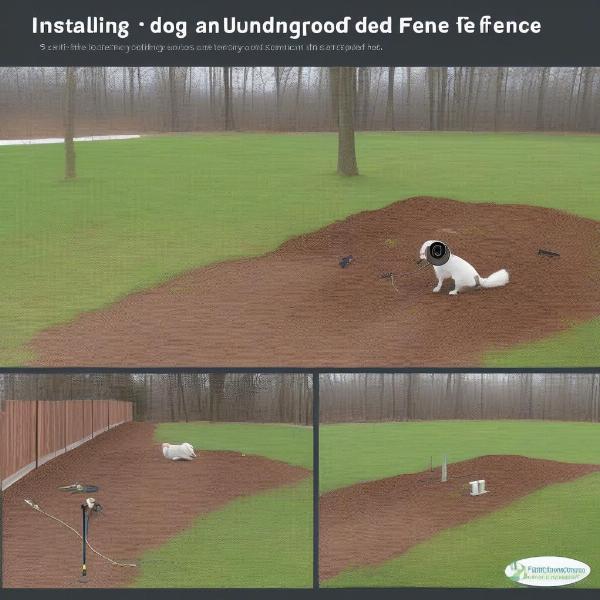Ground dogs, often referring to dogs contained by underground fences, are a common sight in many homes. This system offers a convenient way to keep your canine companion safe and within your property boundaries without the visual obstruction of a traditional fence. But what exactly are underground dog fences, and are they the right choice for you and your furry friend? This comprehensive guide will delve into the world of ground dogs, exploring the pros and cons, installation process, training techniques, and important safety considerations.
Understanding Underground Dog Fences
Underground dog fences, also known as invisible fences or electronic fences, create a defined boundary for your dog using a buried wire and a special receiver collar. The wire transmits a radio signal, and when your dog approaches the boundary, the collar emits a warning tone. If your dog continues to move forward, the collar delivers a mild static correction. This system teaches your dog to associate the warning tone with the boundary, eventually keeping them within the designated area without the need for a physical fence.  Installing an Underground Dog Fence
Installing an Underground Dog Fence
Benefits of Underground Dog Fences
Underground fences offer several advantages. They are less visually intrusive than traditional fences, preserving the aesthetics of your property. They can be a more affordable option, especially for large properties where traditional fencing can be expensive. Furthermore, they can be customized to fit the unique shape of your yard, including excluding flower beds or other areas. They are also relatively easy to install and can be moved or adjusted if needed.
Drawbacks of Underground Dog Fences
While convenient, underground fences are not without their drawbacks. They do not prevent other animals from entering your property. Your dog could still be attacked by another animal within the boundary, and the fence won’t stop other dogs or wildlife from coming into your yard. A determined dog might run through the fence, ignoring the static correction, especially if highly stimulated by something outside the boundary. Furthermore, the system requires consistent training and reinforcement for optimal effectiveness.
Installing and Training Your Ground Dog
Installation typically involves burying a wire around the perimeter of your yard and connecting it to a transmitter. Training your dog requires patience and consistency. Start by flagging the boundary line and introducing your dog to the warning tone and correction. Gradually increase the distance your dog can roam within the boundary while reinforcing the training with positive reinforcement. It’s crucial to consult the manufacturer’s instructions for specific installation and training guidelines.
Choosing the Right Underground Dog Fence
Selecting the right fence depends on factors like your dog’s size, temperament, and the size of your property. Consider the range of the transmitter, the type of correction (tone-only or static), and the durability of the collar. Research different brands and read reviews to find the best fit for your needs.
Maintaining Your Underground Dog Fence
Regular maintenance is essential for the proper functioning of your underground fence. Check the wire for breaks or damage, and test the collar and transmitter periodically. Replace batteries in the collar as needed and ensure the contact points are clean and in good condition.
Are Underground Fences Right for Your Ground Dog?
Underground fences can be a suitable option for many dogs and homeowners. However, it’s important to weigh the pros and cons and consider your dog’s individual needs and personality. If you have a dog that is prone to running away or is easily distracted, a traditional fence might be a better choice. Consult with a veterinarian or professional dog trainer for personalized advice.
FAQ
-
Are underground fences safe for dogs? Yes, when used correctly, underground fences are safe and humane. The static correction is mild and designed to deter, not harm.
-
How long does it take to train a dog on an underground fence? Training time varies depending on the dog, but it typically takes several weeks of consistent training.
-
Can underground fences be used for all breeds of dogs? While generally safe for most breeds, some dogs might be more resistant to the training or may experience anxiety.
-
What happens if the power goes out? Most systems have battery backups, but it’s essential to check the manufacturer’s specifications.
-
Can I use an underground fence with multiple dogs? Yes, you can use multiple collars with a single transmitter, but each dog will need their own collar.
-
How deep should the wire be buried? The recommended depth varies depending on the system, but it’s typically a few inches below ground.
-
Can an underground fence be used on a sloped property? Yes, underground fences can be used on sloped properties, but the installation process might be more complex.
Related Articles on ILM Dog
- underground dog fence for large dogs
- best underground dog fence for large dogs
- above ground swimming pool ramp for dogs
- above ground pool for dogs
About ILM Dog
ILM Dog is your trusted source for all things canine. We offer expert advice on dog breeds, health, training, nutrition, grooming, and much more. From puppy care to senior dog support, we provide comprehensive resources to help you navigate every stage of your dog’s life. We also offer insights into products and accessories to ensure your furry friend has everything they need. For expert guidance and support, reach out to our team at [email protected] or call us at +44 20-3965-8624.